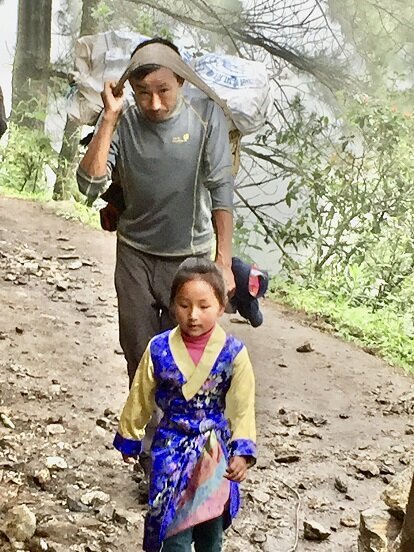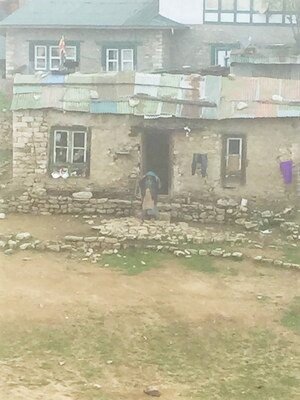vaga #7/6 … life in passing.....
PART VI
In 14 days of trekking, so many things were absorbed, all new, curious and life passing by, …… .. only with what I found when walking, without stopping because I could not, so it will be a chapter of images .
There are too many things to look at, which is overwhelming, overwhelming, and that is why I have already made several chapters towards Everest, but they all go together in 14 days, it is a summation, then comes the Tibetan Buddhism of the national park that is present in every corner and the descent is not free of anecdotes
The porters who stop to talk with each other for a few minutes and continue on their way, the women who came very animated talking loudly, I actually recorded them.
the children, the few that I saw, were minors of school going age, about 5 schoolchildren that I once passed by, they were walking together towards school in uniform. The school was an hour away across the valley and in any weather, they have to walk. I asked them in English - how are you? all in unison answered me - very good and you? - plop, I was not expecting it, how cute and without any shyness. The government has a strict plan to teach English to the highest standard possible, which it agrees is a necessary tool.
women doing their chores outside the home; washing pots, there is no water in the houses, drying and washing clothes by the river, they were very animated and talking.
In the photos below you can see at the top of the photo Rafael walking on the bridge. In almost all the photos are the sacred Tibetan flags
Other women, always older and alone, can be seen praying next to the "sacred drums", the last ones were a celebration of a marriage under torrential rain and very late in the afternoon, they were going down a narrow and muddy ravine, protecting themselves with umbrellas in their traditional clothes. I felt the music and the curiosity before the fatigue. I looked out the window and saw them passing by the side.
they live off self-cultivation, orchards, wheat, potatoes, little rice, animals were few and water buffaloes were the most common
The stonemasons were the first I came across doing construction work. The first time I heard from afar the sound of the chisel hitting the stone and the rhythm of its sound and I saw it several times.
The blow of the chisel against the stone was unmistakable for me and when I heard it my soul jumped with emotion, I had to get closer, to watch them work. Neither Gopal nor Rafa understood why I kept looking at them for a long time and recorded them in their work.
I suddenly remembered my days at the university where I did stonework. Classes that fascinated me. The stone, its colors, veins, hardness, knowing where each type of them is found, in some rivers, in the mountains, in some distant quarry. Add to this my friendship with Pancho Gazitúa, a great Chilean sculptor, who we ran into in the ex Yugoslavia in the early 80's in a marble quarry. He was with his English students and there I learned the whole process of cutting stone slices from the quarry. It is a technique and knowledge passed down for generations in a very, very small group that knows about this skill of cutting stone in the quarry. Many years later in the interior of the Talca-Chile mountain range, He invited me to spend a few days with nine select international sculptors to make sculptures on the site where the stone was located. I was fortunate to be invited (at that moment I was the only one) to observe and share, be under the same roof, see their progress, listen to long conversations at dinner by the fire, about the stone and how to give a new life to it. or the discussions of logistics of how to lower and move those tremendous works near the coast of San Antonio, and several other issues. That is why the sound of the chisel unearthed these memories almost forgotten with pleasure, that sound tak tak tak brought them to light. And it made me happy to enjoy that time again. And knowing that it is another of the skills, stonemasonry, which is in retreat, it is difficult to find them. The stone has been replaced by the practical and cheap cement blocks, industrial pavers, or by the floor ceramics, some imitating stone and they do not look bad. I appreciate what I see more because I know that the handcrafts on the planet are going to extinguish the tradition of passing the techniques between families. A very sensitive recurring theme of mine and I will not delve further about handicrafts and their fragile and uncertain future.
The photo of the roofing work is at a height of 4 thousand metres. I took the photo one morning, I found a beautiful landscape with that in the background. They could only work a couple of months a year because of the weather.
I have already shown some of the houses of the Lukla and Namche Bazaar villages with their beautiful stone architecture, and their almost always teal coloured frames.
I saw a plan in a community house in Namche Bazaar and took this photo. On the first floor there is a place to store the animals, another for firewood, a hole to store potatoes and wheat, always thinking about the winter months, in one corner there is a stone pile that contains the spirit of the house, a compost and a chimney. The second floor, the largest and almost private space is the chapel, the rest are shelves, tables, the main bed, bathroom, and kitchen. Generally they cook on the floor with a fire, nowadays they have access to a gas stove, but for many it is inaccessible due to the cost of having gas at that height, each cannister is raised on the shoulders and it can be 7 or more days walking, outside the prayer flag or the Tibetan flag that is vertical and narrow
“Doors” have always intrigued me, what is behind it? and I love them, with their old, new, originals and they give the house personality. In the windows many offer merchandise for sale
public toilets
“The porters” in this case are Sherpas in their region. It does not leave me indifferent to see them passing by and especially them going up with loads and us going down. When we went up they came down without a load walking fast and relaxed talking.
When I saw the loads, I was speechless. I would take a hidden photo of it because it was impressive; Construction irons, cement, plastic containers, nail boxes, oak beams and whatever there is. Then after a week I erased everything, I was ashamed to register a system of life, sustenance and supply so hard where youth and health are destroyed. I had some by accident that I will put in and not the most shocking to tell the story. Our Sherpa Pemba carrying our luggage was an easy and weight controlled task, the others have no weight limit.
Back in Lukla there were many preparing their baskets (backpacks) with supplies of food. Baskets of various shapes, each one uses what it needs according to the type of load or if it fits. A young tourist, Spanish, who we met in a tea house angrily claimed that bottled water was becoming more and more expensive for her. I wonder how conscientious she was, how she didn't see that they carried the water on their backs and the higher they were, they had to walk further and they had to pay to sleep the extra days and it is more expensive, it is obvious. Those things kill me the lack of sensitivity, of just looking at the navel, demanding, ignorant of the environment they visit. That is why I avoid conversations with other foreigners, the vast majority are totally immune to seeing that there are other unhappy or crude realities.
Gopal looked very carefully and took his time to see that package of processed and tied lumber, he felt the weight the way it is tied and that crossed plank gave the idea that a single man carries it and by his contrite face I intuited how heavy it was. The last photo is the largest basket I have seen.
It gave me a relief to see on the third day a group of donkeys, some with decorations and bells around their necks, and they rattled as they passed us. They were carrying stone slabs and a muleteer behind, it was a respite to see other transportation alternatives, then there were the water buffalo, horses that also do the loading work.
The yak is an animal that only lives in the Himalayas, it supports a height of over 4 thousand metres and the cold, many degrees below zero, its thick fur covers it. Milk, cheese, and meat, is what is obtained as food and from the fur, covers and coats, the meat is somewhat tough. I saw several young yak a couple of weeks old playing like cubs
In the Himalayas the flora occurs over 5,000 meters high, the forests over 3,000, compared to the Andes and the Alps that occur up to 2000 meters. Some protected plants next to a rock, others adapted to the wind and these have flat, low and hard leaves at ground level. A little miracle. It is appreciated to see them among so many rocks and rugged landscape that one walks for days …… a violet one appears… a yellow one there… I don't know how they survive, with the lack of oxygen, or which insect pollinates them.
I end by thanking the brave, strong and fragile "flowers", whose colours when I saw them as I passed gave me joy. Protected in a crevasse, in a small space behind the rocks and there they endured the worst of storms, wind and cold and they reinvent themselves each season after 9 months of snow.








































































































































